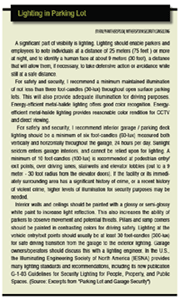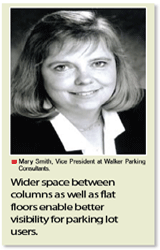Many of us are frightened by dark and isolated parking lots. Indeed, poor design in parking facilities makes them attractive places for crimes. Through the use of a few fundamental strategies, safer parking lots can be maintained.
Many of us are frightened by dark and isolated parking lots. Indeed, poor design in parking facilities makes them attractive places for crimes. Through the use of a few fundamental strategies, safer parking lots can be maintained.
(1).gif)
Many parking owners and operators have not paid as much attention to security as they should. There are no clear laws governing how parking lot owners or operators should protect customers from criminal acts that may occur on their premises, nor are there laws outlining liability.
Two issues prevail in parking lot security, said William VanRyswyk, President and CEO, Security Through Safe Design Inc. First, parking lot owners and operators assume that a criminal event will never occur in their lots because it has never happened before. Secondly, the main concern for parking lot operators has been how to generate more revenue, as parking lot operation can be very competitive. "To many operators, it comes down to the dollar issue because they think it is too expensive to implement security strategies," added VanRyswyk.
Common parking lot crimes include vandalism, theft and violent crime such as purse snatching, robbery and abduction. "In Canada," said VanRyswyk, "car theft was reported as the No. 1 crime with more than 160,000 motor vehicles stolen per year (438 per day)."

In the U.S., statistics show that parking lots attract more crimes that result in companies being sued more than in any other corporate settings. In fact, a respected litigation analysis firm estimated that 38 percent of robberies and 17 percent of sexual assaults on American workers occur while walking to or from parked cars. The data was presented in a teleconference "Fighting Parking Lot Crime" held by Strafford Publications, one of the leading national publishers of legal information in the U.S.
Many criminal activities in shopping centers and business offices also take place in parking lots. Failing to stop a preventable attack can lead companies to costly law suits or settlements. Crime victims or families may sue retailers for not implementing sufficient security measures, or not taking reasonable care in protecting employees and customers against criminal threats.
So how do parking professionals make their premises safe for potential customers and staff?
Different Problems in Different Parking Lots
Parking lots are often attached or adjacent to institutions, anddepending on the institution's purposedifferent parking lots have different problems. When designing security strategies for parking lots, environment and the surrounding community are the very first elements to look. Time of day and location can have a huge impact on safety. "It is not just your garage; you also have to address the whole community," said VanRyswick.
.gif)
For instance, a parking garage in the entertainment district of a downtown core with a lot of bars and restaurants that are open until early morning will have different requirements than those that are located in an upscale residential apartment that is open only to registered residents. Finally, a parking facility next to a courthouse or embassy may have even higher requirements.
"Government facilities or those that may be potential targets make use of products that are focused more on stopping a vehicle with certainty, while a casino or university will use products that are less likely to cause damage to a vehicle," explained Brad Chisling, Sales Manager at Canadian Parking Equipment. "The choice of access control card or identification system robustness also typically parallels this difference."
Types of Parking Structures
Parking lots can be divided into the following three categories: high-rise or multiple-level parking structures, underground parking lots and surface parking lots. High-rise parking facilities often have poor visibility because of walls, pillars, posts and columns, making effective surveillance or monitoring difficult. Underground parking lots are usually part of the main foundation of buildings and can be several floors below ground; they are usually fully enclosed. Underground parking lots are also vulnerable and, in recent years, have been a target for terrorism.
"The other problem with high-rise and underground parking is fire code regulations. They have emergency stairwells that lead to the exterior; criminals can use these exits as a means to escape after they have broken into a car or after a potential assault," said VanRyswick.
Flat or surface parking lots often lack proper access or perimeter control. The larger the size of the surface parking, the more difficult it is for operators to control access. "The main concern with surface parking is that people on foot will gain access. If you have an open lot that is not enclosed by a fence or if there is no access control, people walking down the road will use the parking lot as a short cut," said VanRyswick. "This may cause random vehicle crime to be higher, such as broken windows and valuables stolen or even car theft."
Lighting: An Economical Security Investment
Adequate lighting is the simplest and most basic form of security. Adequate lighting not only helps people spot and stay away from dangers by clearing out dark and shadowy areas, but also deters criminals by creating fear of detection.
According to Mary Smith, Vice President at Walker Parking Consultants, "It is important to use a minimum of two-foot candles in a standard parking lot due to the heavy drains on power grids. In high-risk areas, a minimum of five-foot candles is recommended."
"Quite often, we see substandard lighting in parking lots," pointed out VanRyswick. It is more important to have consistent lighting so that it is bright throughout the lot. This is to be much preferred to spontaneous lighting with really bright lights, but with dark areas. "Even at a lower levelas long as it is constantlighting is effective," added VanRyswick.
Another strategy is to paint the walls white. Painting walls white can make bright lighting even more effective. "Light reflects better on white surfaces than gray cement walls. Just by painting walls white, you increase luminance in respect to brightness of the area," said VanRyswick.
Visibility and Visual Surveillance
Proper design offers good visibility and visual surveillance. Stairwells, pillars, beams, poles and landscapes in surface parking lots need to be as visible as possible.
Stairwells
One area of concern is cut-away areas beneath stairways in stair towers. Where possible, interior and exterior stairwells should be visible, either by incorporating glass, windows or see-through materials or by removing as much wall as possible. This approach provides an early caution of potential threats for the users.
"We are trying to position the stairwell so that there is natural light and lots of opportunities for outside surveillance. Glass enclosures, metal bars and wire mesh let in natural light. This is even better than use of artificial light," said VanRyswick.
Walls, Pillars and Floors
It is hard to refit an existing high-rise parking structure that may have been built 20 years ago to address today's security concerns. That is why it is important to work with professional architectural design firms so that visual surveillance can be enhanced.
"Where solid doors are necessary, install large metal grates at eye level to increase visibility and audibility. When using cement walls and pillars, we use things like holes through pillars so that you can see things behind the pillars," said VanRyswick.
"Before, we used columns that were closely spaced; now, we are able to stretch that out to 30 or sometimes 45 feet between columns, improving visibility," said Smith. Use of flat floors rather than sloping ones enables those parking to better see and be seen, added Smith.

Landscaping is another consideration because high and dense shrubs provide hiding places for potential criminals. Parking managers should ensure that any bushes, shrubs, flowers and trees kept low and that such greenery does not obstruct views.
Standoff strategy
Stand-off distanceone strategy commonly used in North Americaensures that all public vehicles park 30 meters (100 feet) away from main buildings. In the U.S., the airport regulation set by the Federal Aviation Administration requires that public parking lots be at least 300 feet away. In addition, air terminal buildings that have public parking less than 300 feet away must undergo bomb analysis to study what damage would result if a bomb went off in the public parking lot.
"Catastrophic damage is reduced if bombs are pushed farther away," said Smith. "The farther away, the lower the bomb damage. At 100 meters, it will likely cause glass breakage, but no serious damage." Most high-risk federal government buildings allow only employees and long-term tenants to park close to the building; the rest of the public is kept farther away, said Smith.